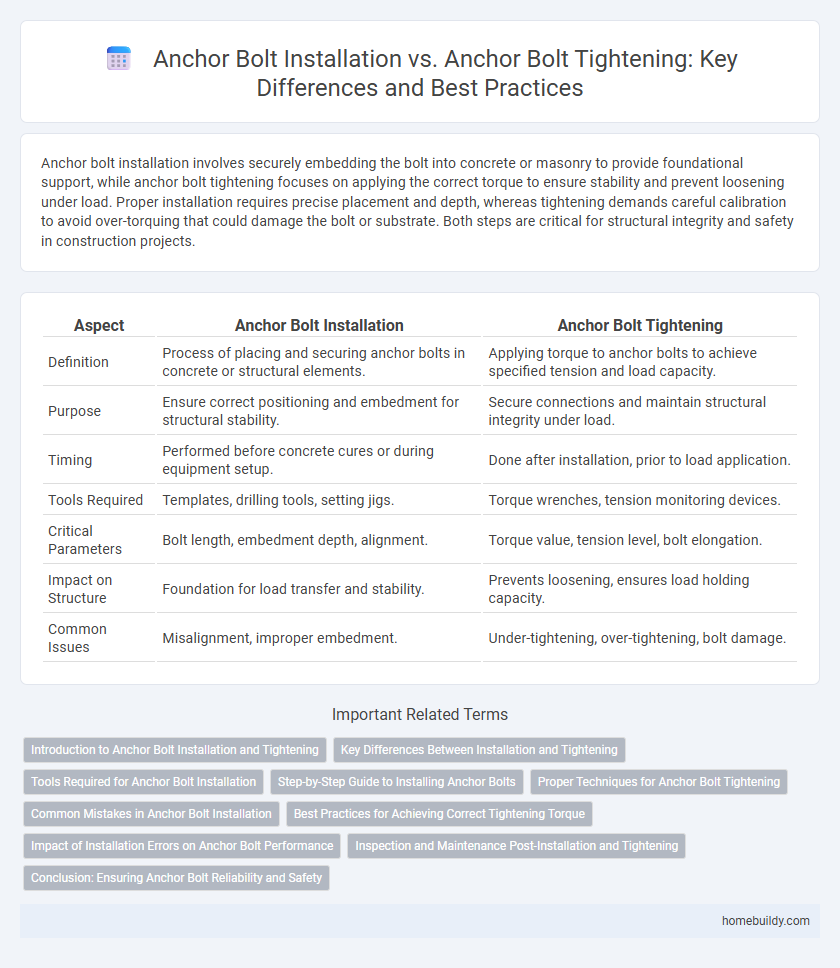Anchor bolt installation involves securely embedding the bolt into concrete or masonry to provide foundational support, while anchor bolt tightening focuses on applying the correct torque to ensure stability and prevent loosening under load. Proper installation requires precise placement and depth, whereas tightening demands careful calibration to avoid over-torquing that could damage the bolt or substrate. Both steps are critical for structural integrity and safety in construction projects.
Table of Comparison
| Aspect | Anchor Bolt Installation | Anchor Bolt Tightening |
|---|---|---|
| Definition | Process of placing and securing anchor bolts in concrete or structural elements. | Applying torque to anchor bolts to achieve specified tension and load capacity. |
| Purpose | Ensure correct positioning and embedment for structural stability. | Secure connections and maintain structural integrity under load. |
| Timing | Performed before concrete cures or during equipment setup. | Done after installation, prior to load application. |
| Tools Required | Templates, drilling tools, setting jigs. | Torque wrenches, tension monitoring devices. |
| Critical Parameters | Bolt length, embedment depth, alignment. | Torque value, tension level, bolt elongation. |
| Impact on Structure | Foundation for load transfer and stability. | Prevents loosening, ensures load holding capacity. |
| Common Issues | Misalignment, improper embedment. | Under-tightening, over-tightening, bolt damage. |
Introduction to Anchor Bolt Installation and Tightening
Anchor bolt installation involves embedding bolts into concrete or masonry to secure structural elements, ensuring proper alignment and depth based on engineering specifications. Anchor bolt tightening follows installation, applying precise torque to achieve optimal clamping force and structural stability without causing damage to the bolt or substrate. Correct installation and tightening processes are critical for the anchor bolt's load-bearing performance and long-term durability in construction projects.
Key Differences Between Installation and Tightening
Anchor bolt installation involves positioning and securing the bolt in concrete or masonry to provide structural support, ensuring proper alignment and embedment depth. Anchor bolt tightening refers to applying torque to the nut after installation to achieve the required clamping force and prevent loosening under load. The key differences lie in installation focusing on placement and initial securing, while tightening ensures durability and load-bearing capacity through controlled torque application.
Tools Required for Anchor Bolt Installation
Anchor bolt installation requires heavy-duty tools such as impact drills for drilling precise holes, concrete anchors for securing the bolt, and a torque wrench to ensure the correct bolt tension during tightening. Proper alignment tools, including levels and templates, guarantee accurate placement before the bolt is set in place. Safety equipment like gloves and eye protection are essential throughout the installation and tightening process to prevent injury.
Step-by-Step Guide to Installing Anchor Bolts
Anchor bolt installation begins with precise layout and drilling holes that match bolt size and embedment depth, ensuring structural integrity. Proper cleaning of holes removes debris, allowing for secure setting of bolts in epoxy or grout, which enhances bonding strength. Tightening anchor bolts follows installation, using a calibrated torque wrench to achieve manufacturer-specified torque values, preventing overtightening and structural stress.
Proper Techniques for Anchor Bolt Tightening
Proper techniques for anchor bolt tightening ensure structural integrity by applying the correct torque to avoid bolt damage or loosening. Using calibrated torque wrenches and following specified tightening sequences prevent uneven stress distribution. Consistent monitoring during tightening maintains anchor bolt performance and enhances safety in construction applications.
Common Mistakes in Anchor Bolt Installation
Common mistakes in anchor bolt installation include improper alignment, insufficient embedment depth, and failing to clean bolt holes before setting, which compromise structural integrity. Over-tightening anchor bolts can cause thread damage and reduced load capacity, while under-tightening leads to inadequate clamp force and possible joint movement. Ensuring correct torque values and following manufacturer specifications prevent these errors and enhance anchor bolt performance.
Best Practices for Achieving Correct Tightening Torque
Proper anchor bolt installation requires precise torque application to ensure structural integrity and safety. Best practices for achieving correct tightening torque include using calibrated torque wrenches, following manufacturer specifications, and applying torque in stages to avoid over-tightening or under-tightening. Consistent verification of torque values during installation prevents bolt loosening and ensures optimal load distribution.
Impact of Installation Errors on Anchor Bolt Performance
Anchor bolt installation errors such as improper embedment depth, misalignment, or insufficient tightening torque significantly reduce the bolt's load-bearing capacity and structural integrity. Incorrect installation can cause uneven stress distribution, leading to premature failure or loosening under dynamic loads. Proper tightening is essential to achieve the designed clamping force, as under- or over-tightening compromises the anchor bolt's performance and safety.
Inspection and Maintenance Post-Installation and Tightening
Anchor bolt installation requires precise alignment and embedment depth verification, while tightening focuses on achieving specified torque values to ensure structural integrity. Post-installation inspection includes checking for proper embedment, absence of damage, and correct positioning relative to structural elements. Maintenance involves periodic torque rechecks and corrosion assessments to prevent loosening and ensure long-term performance of the anchorage system.
Conclusion: Ensuring Anchor Bolt Reliability and Safety
Proper installation of anchor bolts establishes secure foundation support by accurately positioning and embedding bolts into concrete or structural elements. Tightening ensures the bolt maintains necessary tension to resist operational stresses, preventing loosening and structural failures. Consistent adherence to installation and tightening specifications guarantees long-term reliability and safety in anchoring applications.
anchor bolt installation vs anchor bolt tightening Infographic

 homebuildy.com
homebuildy.com